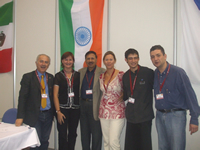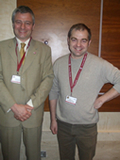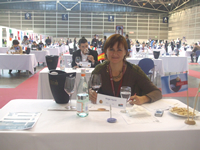 |
| Jury No. 1 with the Sommelier |
A total of 5992 wines took part in the annual international 3-day competition with almost a third, 2014 wines from France leading the pack, followed by Spain with over 20%, 1235 wines and Italy with 604 wines.
The smallest contingent was from Moravia, Czech Republic with a sample of three wines. Indian tri-colour flew in all its glory-but only because an Indian judge was invited to take part. There was no participation from any wine producers although the Indian spirits did the country proud by marking their presence with 3 labels.
Forty groups of jurors, each consisting of 5-7 judges from over 40 countries decided the medals to be awarded based on blind tasting.
The competition from 25-27 April coincided with the second edition of biennial wine show Vinoelite also held in the same fair complex, Feria Valencia on 26-28 April.
International Venues:
‘Concours Mondial seems to be the only international wine competition which changes its venue every year’, says Baudouin Havaux, the General Manager. His father Louis Havaux started the competition in Brussels in 1994 but has given the control to the son, relegating himself to the role of only a judge at the competition. ‘In 2006 we decided to go international in terms of selecting a venue and went to Portugal, followed by Maastricht (2007), Bordeaux (2008) and Valencia this year,’ he added.
The next year’s venue was announced as Palermo, at the gala dinner organized with great élan, pomp and show, music and an accomplished Italian dancer, an entertaining master chef from Sicily- the wildest spirited event seen ever. Hosting a venue has an advantage- the host country and specifically the region in which it is being held, gets an opportunity to showcase its gastronomy and wines to around 250 journalists from throughout the world.
At the conclusion of the competition I met a local politician from Sophia at a beautiful 27-hole golf resort in the nearby wine producing region of Alicante, El Plantio Golf Club, Stoyko Dukov, a young member of the Sofia City Council was there with a group of four Bulgarians, including Eng Rossitsa Goranova, the Executive Director in the Ministry of Agriculture and Food (similar to Indian National Grape Board). Their aim was to convince the organisers to consider Sophia as a venue soon. Said Stoyko, ‘we make good wine in Sophia. Where else will we get such a great opportunity to showcase our wines, wineries and winemakers to the opinion maker journalists and sommeliers throughout the world?’
Here com’ the Judge, now here com’ the judge
 |
| Baudouin Havaux. President and Thomas Costenoble, Director of the Show |
Wines are judged by following a numbering system that allows a max of 100 points based on colour, aromas, Flavour, end and overall impression.
The blind tastings for the wine competition take place under the directions of Paris based OIV-International Organisation of Vines and Wines, during three mornings, from 08:30 am to 01:00 pm when the palate is fresh and raring to go. ‘The jury is composed of around forty groups of five to seven tasters. The wines received in Brussels are stored in temperature controlled cellars and are transported to the venue similarly. Samples from the host country remain stored in a similar fashion and are brought to the venue in a temperature controlled container. Service is at the proper temperatures for all the wines and sommeliers from the local association are selected for the professional service,’ said Thomas Costenoble, enologist Director of the competition.
‘All the series of wines proposed in the tastings to the international jury are organised in such a fashion as to maintain the total anonymity of the samples both on the label and bottle shape level; the only detail revealed to the tasters being the colour and vintage,’ he added.
The average score given by the jury, as modified by the statistical correction allows silver wines for 84 points and above. 92.5 allow a gold where as 93 or above brings them a great gold.
Besides the medals, trophies are given for Best Wines in each of the following categories:
- ‘Best White Wine’ for still white wines
- ‘Best Red Wine’ for still red wines
- ‘Best Sparkling Wine’ for sparkling wines
- ‘Best Sweet Wine’ for sweet wines
- 'Best Rosé Wine' for still rosé wines
Calculation of results
‘At Concours Mondial de Bruxelles we try to do our best in the field of sensory evaluation in order to guarantee to the producers a maximum of rigour, effectiveness and equity in the attribution of medals,’ adds Thomas.
‘For many years, we have has collaborated with the Statistical Institute of the University of Louvain to analyze and optimize the reliability of the results by identifying some principal distortions like excessive variability between different juries, repeatability, reproducibility, etc.,’ he explains.
 |
| Tasting in Session |
It might not have been a coincidence or mistake that on the last day our group was given the same wine twice to taste, without the knowledge of the judges. It was gratifying to know when the scoring sheets disclosing the wine, and the country were handed out that I had given the same wine unwittingly, 83 (no Medal) in once case and 85 (silver) in the other. Of course, we might never know how each of these wines had rated overall by our panel, as it always remains a secret.
The statistical formula of treatment limits the differences between the marks allotted by the most severe and most generous tasters; it brings back all the marks to the same scale.
No discussions are allowed and the taster has to do the judging on his/her own in a quiet and temperature controlled environment, without consulting the other tasters. Any change of points after scoring once is frowned upon. In that sense, it is different from some other major international competitions where discussion is allowed amongst the jurors and they are welcome to argue, till they come to consensus while rating a wine.
For results and other details, click |